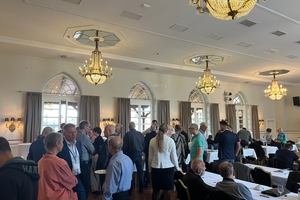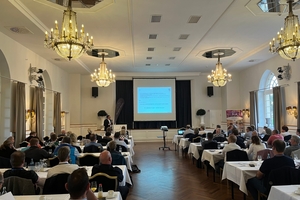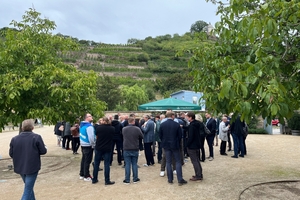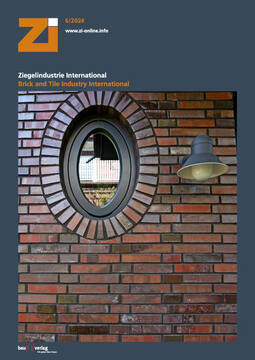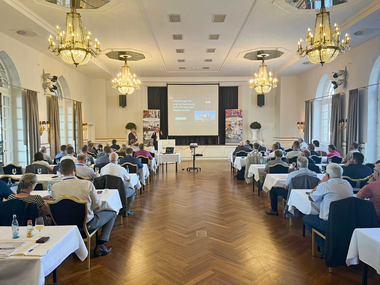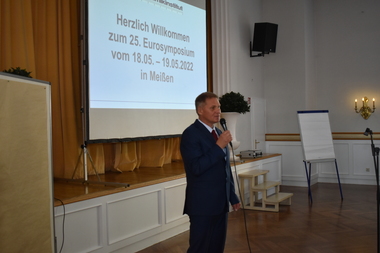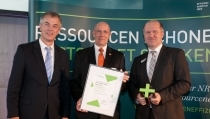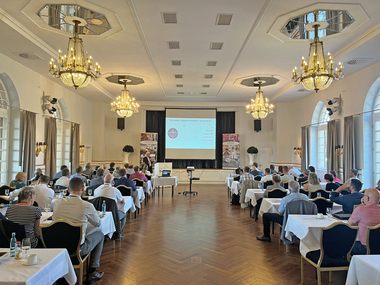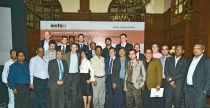Eurosymposium 2024: A look into the future of ceramics
This year‘s Eurosymposium, organised by the Keramik-Institut in Meißen (KI), was entitled „Ceramic products shape our future“. Around 80 participants gathered in the conference hall of the Romantik Hotel in Meissen on 11 and 12 September 2024.
Meissen was the city of ceramics and will continue to be so in the future, emphasised Managing Director Dr Jens Petzold in his opening address, as did also both Mayor Markus Renner and the Head of Cultural Affairs in their welcoming speeches. A few months earlier, the city, the institute and the institute‘s affiliated company CeraFib GmbH had been honoured with a prize for the „Municipal Intelligence“ project in the Saxony-wide simul+Kreativ GmbH hands-on competition. The aim is to rediscover and further develop regional expertise in the material potential of ceramics. CeraFib GmbH produces ceramic fibres, fabrics and composite materials for various industrial applications. The ZI will report.
In the first presentation, Klaus Oberpichler, Franz Banke GmbH, explained how energy can be saved in roof tile production through design changes. One variant is to reduce the weight of roof tile models, which reduces the costs for preparation, drying and firing. The limits of this method are determined by standards (e.g. EN 1304) and the requirements of use on the roof. Other approaches include making better use of existing drying frames and firing cassettes to increase the surface area, optimising the brick profile to reduce wear on the plaster inserts or improving the placement of pressed bricks to avoid deformation and rejects.
Frank Appel, innovatherm Prof. Dr. Leisenberg GmbH + Co. KG, presented reference projects in which energy consumption and CO2 emissions were minimised by dosing gas and combustion air. The guiding principle is to reduce the amount of combustion air to be heated by dosing it as precisely as possible. This is possible with the use of solenoid metering valves manufactured by innovatherm. The reduction of the air volume in the tunnel kiln has led to energy and CO2 savings of 17 per cent in various reference projects. The temperature and, as a result, the product colour have also become more uniform.
The third and final presentation on the first day examined dilatometry as a tool for product development. KI employee Klaus Hantzsch explained how knowledge of the expansion and shrinkage behaviour of clay bodies allows conclusions to be drawn, for example about their suitability for certain products such as roof tiles. It can also be used to check whether the thermal expansion coefficient of the body and glaze match. Dilatometry can also help to clarify, for example, whether the firing temperature can be lowered or the firing time shortened. The influence of the atmosphere can also be determined in this way. These analyses can be carried out without great effort and during ongoing production and can help to save time and energy.
The traditional excursion on the evening of the first day of the conference led this time to Wackerbarth Castle in Radebeul. The baroque castle is surrounded by vineyards and is home to the Saxon State Winery. A guided tour through the production facilities of the wine and sparkling wine manufactory provided interesting insights into the modern, partially industrialised production of fermented grape beverages. Some of the products could also be tasted, which was conducive to the visitors‘ understanding and the relaxed atmosphere. With a buffet and further tastings from the winery, the evening proceeded lively and convivial.
Rainer Hüsing from Keller HCW GmbH opened the programme for the second day with his presentation „Transformation of the energy system - best practice: implemented heat recovery concepts“. Heat recovery can be divided into three areas of application: Direct waste heat utilisation through internal use of the heat flows in the plant, indirect waste heat utilisation from flue gas of the hot air with, for example, a heat exchanger, and treatment of the waste heat using a heat pump or storage tank. Using two examples of indirect waste heat utilisation, Hüsing made it clear that heat recovery from waste heat is a measure with high potential, but that it depends on the location and can only be implemented individually.
Geologist Alexander Metz from the BMI Group‘s Raw Material Security division provided information on ceramic raw materials in South Africa. The country has extensive and diverse clay deposits, including kaolin, bentonite, refractory and brick clays. The clay is mainly used for the production of bricks. In South Africa, around 100 brickworks produce 3.6 billion bricks a year. One challenge for local brick manufacturers is that they often lack the financial resources for the necessary mining equipment to extract the existing high-quality clay.
Markku Ruokanen from the Insulation Technology Group discussed the ageing mechanisms and resistance of C-130 ceramic high-voltage insulators. The ageing of components is a risk factor in transmission networks. Estimating the remaining service life as precisely as possible is therefore important, but difficult due to the complex mechanisms of ageing (physical, biological, chemical and mechanical). Studies show that the purely ceramic components of insulators only age mechanically under normal operating conditions and are significantly more durable than assumed. This means that ceramics represent an ecological and sustainable solution for high-voltage insulators.
In the last presentation of the symposium, Rüdiger Köhler from KI discussed the use of sediments from dams in the brick and tile industry. This is a sub-topic of the ReSus research project, Recycling of sub-hydric sediments, at TU Freiberg (running from 1 May 2023 to 31 December 2025). Köhler explained how sediments are handled in dams in Saxony and that some of these materials could have potential for the production of backing bricks. In the near future, sediments from the Dobeneck dam are to be tested for their suitability in brickworks.
The Eurosymposium concluded with a lunch. Before concluding the conference, Dr Petzold thanked all participants and invited everybody to the next Eurosymposium on 10 and 11 September 2025.

